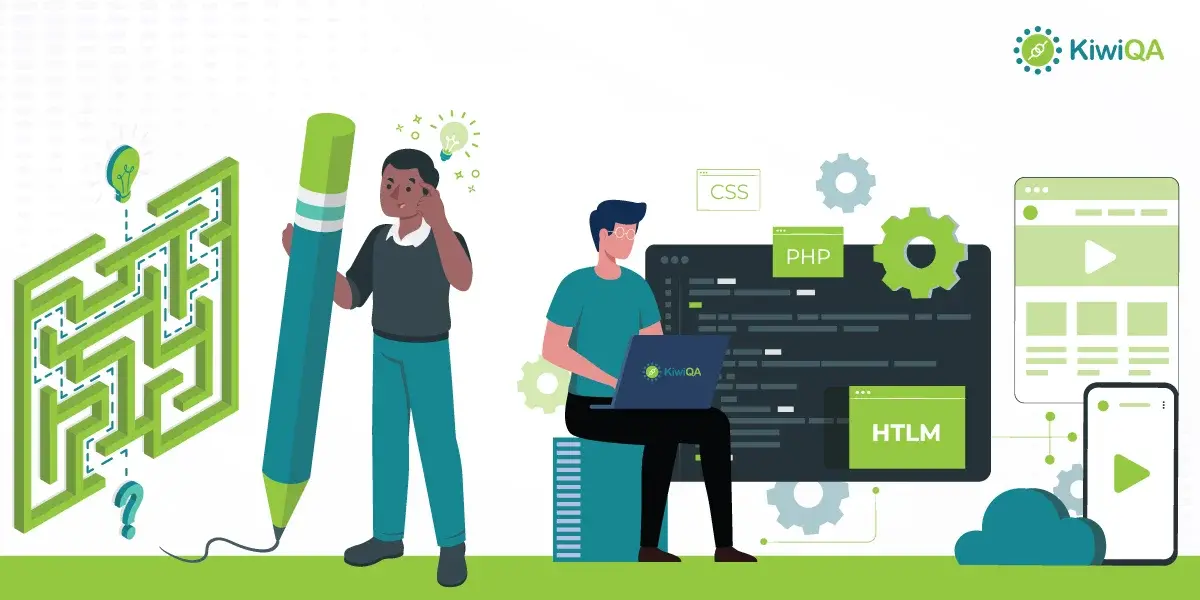Advanced Solutions For Web Application Testing Challenges

 KiwiQA
KiwiQAIn today’s scenario, when we are using many web applications in our everyday lives, it is important to ensure the accuracy and performance of web applications. The web applications should be tested thoroughly to ensure that they work well across all platforms and through different scenarios. Web application testing is as necessary for a brand as the development of the actual application. Web applications might have a lot of features and capabilities that need to be tested minutely.
As the web application landscape keeps evolving, there are a lot of challenges that exist for web application testers and developers. The challenges need to be resolved with appropriate solutions aimed at specific problems. Assuring the quality of the web application ensures that the product is very popular and established in the app landscape.
The web application testing and development lifecycle needs to be followed properly for the product to be top-notch. The phases of development and testing ensure that the whole process is productive and has a high turnaround time. The testing phase should include different test processes and cases to prepare the MVP for different scenarios in the future.
Testing in an extensive manner plays a huge role in quality assurance and ensuring the KPIs of the application. The testing process supported by strong feedback channels and fast improvements can ensure that the final version of the web application protects its integrity and functions flawlessly across different platforms and systems.
The testing process, when executed with accuracy, ensures that the user gains relevant and enhanced experience from the application interface. The test cases and their outcome not only make sure that the back end is secure and strong but also ensure that the front end is working smoothly.
The interface is maintained properly and offers a seamless user experience after all the quality assurance rounds. Along with all the different test cases to be run on the application framework, it is also important to run web application security testing processes on the app product to ensure network and internal security.
Let us look into the common challenges faced in testing web applications and how to secure the testing environment for more effective testing results and improvements. What are the common problems faced in web testing? Read to find out.
Today, since people use different browsers across different devices and platforms, it is important to ensure that the web application is compatible with different browsers. The cross-browser compatibility needs to be checked and tested properly for the web application to work properly.
The most common cross-browser challenge to address during testing of the application is to not test the app enough on different browsers and different devices. Different devices have different interfaces, which can give rise to a lot of compatibility issues in the web application. The glitches in layout compatibility across devices and the detection of browser-specific issues are web application testing challenges that can be reduced by testing for cross-browser functionality.
There is also the possibility that the web application faces problems in executing the code written in JavaScript and AJAX when run on browsers. The dynamic content might not work properly with the browser and device interface. The testers and developers need to focus on improving dynamic content and creating a scope for better handling.
The testing team for the web application can use dynamic content testing processes like defining the test scope and then using dynamic locators for the testing process. Using tools meant for dynamic content testing and ensuring the use of a data-driven testing approach is a way of handling dynamic content.
The testing team also needs to test the web app under load and distress to check for its traffic threshold. It is possible that the web application will witness a lot of demand and experience heavy loads of visitors. The testers need to check for the load that the app can handle. The development team can then focus on improving the load-bearing capacity and reducing the downtime for the application.
The testers also need to create and execute performance testing cases on the application to ensure that the app is high-performance in all conditions. The testing team has to create accurate test cases and infrastructure monitoring processes to avoid the common pitfalls of web application performance testing.
Injection Attacks are some of the common security risks and data threats that might affect the web application. The testing team needs to reduce vulnerabilities to avoid the chances of injection attacks and other issues. The security risks can materialize as unauthorized access and other security breaches through the browser and emails. Broken authentication and other issues need to be addressed through proper testing and improvements.
There are many ways in which security testing can be optimized and improved for web application testing. The use of automated tools for testing is a proven way of improving the speed and output of security testing, and the security testing approach needs to be minute and detailed so that the testing does not occur again and again.
The testing team needs to be fully available and dedicated to the testing process and environment. Having insufficient bandwidth for the process and struggling with the timelines can be a huge challenge for web application testing. The team has to be professional and experienced with all the right equipment and tools to test the web application properly. Insufficient bandwidth can end up leaving the testing process incomplete and hasty.
The web applications that are tested might have complex features and a complicated infrastructure. In this case, there could be huge UI testing challenges that arise from testing all the application components and features one by one. The process can be lengthy and resource-consuming, which is a major challenge to tackle for the team. If the testing and development team decides to change the UI frequently, the testing process can be unnecessarily complicated and difficult for the team.
The altering of the environment and the use of the testing environment might be difficult for the testing team to handle. If the testing team is altering the environment for the application testing, then the tools and techniques need to be changed and opted properly.
When designing the test cases, the testing professionals have to stay in line with the compliance and industry standards for the application. The web application should be tested according to the rules and policies that govern the browser and application testing process.
Today, the development and deployment of applications have to be done very fast. The short deadlines and low timelines cannot be compromised. However, the team cannot also compromise the quality of the final product. The introduction of automated testing and speeding up of testing processes support the faster deployment demand in the application development market.
The web application testing team can learn the skills of automation testing and use automation testing tools for testing cases and processes. Since automated testing is very popular in the present scenario, it is also important to know that there are many advanced testing tools that run on automation.
There are many advanced testing tools that can be deployed for testing and improvements as an automated framework. A good automation framework is Cypress, which is an independent automation testing framework. You can also choose testing tools like Selenium testing framework or Playwright for the web application testing process. The testing framework should be easy to use and fast in response. The tools and frameworks that your company chooses should also be affordable, open source, and accessible web application testing solutions so that your team can easily use them for every web application testing.
Cloud-based testing can be very popular for the next few years as it is simple and optimized for different devices. Cloud-based testing can have many benefits for startups and large-scale businesses. For example, cloud-based testing can be done to save money. The cloud testing processes are very cost-effective as all the processes happen on the cloud. The cost-effectiveness is an advantage for small-scale businesses and startups.
Another benefit of cloud testing is that the resources for testing will be available online for the entire team very easily. Anyone with authorization can access the resources from any device at any time, so the processes can be streamlined and completed at all facets. The resources can be easily scaled up and used for any kind of testing cases and instances. The scalability of the automated cloud testing solutions is also a huge advantage that trained testers get.
The best way to use cloud platforms for web application testing is to create useful test cases that are customized to the needs and goals of the project. Having properly trained professionals and executives at the endpoints can maximize the cloud capabilities for web application testing.
The CI/CD pipeline is in place to manage the continuous feedback and deployment processes. The CI/CD pipeline needs to be strengthened and improved with continuous integration of tests. After every stage of development is complete, the team needs to do integration testing and integrate the results into the larger code architecture. The integration of the code blocks should be continuous and seamless.
The testing team should conduct integration testing from time to time to ensure that the code blocks are integrated properly. In different phases like code merging and before complete deployment, the team has to conduct extensive tests and share the results with the client. The feedback from the client needs to be taken into consideration for the improvement of the web application code.
There are many tools and strategies that have to be integrated for the continuous delivery pipeline to work properly. The tools and strategies that your company can rely on are Buddy, Jenkins, Buildbot, etc. Buddy is a tool that helps you develop tests for your application testing process. The testing cases can be deployed across the continuous delivery pipeline.
The Buddy framework is used with multiple development languages. The Jenkins framework is used to create tests and testing processes for real-time results and deployment. Tools like Jenkins are very easy to use because they are open-source and free to use. Buildbot, Jenkins, and Buddy are very accessible and have a simple learning curve that testers and developers can follow.
Security testing protocols need to be implemented and deployed in every testing environment of web application testing. Robust security testing measures need to be included in the testing instances to ensure that security vulnerabilities do not arise during the development phases.
The testing, analyzing, and reporting of the security testing results should be done at a fast pace and very transparent manner. The testing and deployment process should be done in such a way that the assets of the web application are detected and prioritized. The integrity and environment of the software application need to be maintained throughout the security testing protocols.
The activities and actions that are taken on the web application should be monitored so that identity threats and other issues are detected. The vulnerabilities and identity threats need to be identified and reduced for a highly effective web application. The identity threat risks and other areas of security vulnerabilities need to be handled in time.
The tester has to focus on the most imminent threats and vulnerabilities before other minor concerns are dealt with. The impact of the security threats at a later stage should be predicted and properly mitigated. The security testing process should not be a passive process because ignorance of security threats can create major issues in the application later on.
The security testing process should include the developers as well as testers. The testers need to communicate clearly about the issues they detect, and the developers need to promptly eliminate the security issues. The nature of the security issues and the problems detected decide the remediation to be taken for the whole application framework.
During the security testing process, there are some values and aspects that need to be followed.
For example, the testing team needs to maintain the confidentiality of the project at hand. Confidentiality of the application structure and information upholds the purpose of security testing. When the confidentiality and integrity of the application are compromised, more security threats might arise and pose a problem for the code base of the web application and its execution.

The security testing team has to check the authorization process and framework to ensure that only authorized users can access the framework of the application. The security tests need to check that the data channels are well maintained and send only authorized and secure data. There are many tools and techniques that need to be used for security testing and remediation.
The most popular tool for security testing is BurpSuite. BurpSuite is a tool that scans the code for security issues, hidden vulnerabilities, and crawling on content. Nessus is also a good security testing tool that works as a vulnerability scanner for the application and its hidden security threats. A number of diverse security testing tools can be used to detect vulnerabilities and threats for the best kind of results and accurate software framework.
Web application testing needs to be done for all modern-day web applications. Now that the demand for web applications has gone up to a high level, it is important to create robust, precise apps that can be used over different web browsers and devices. We have to focus on web application testing so that the web applications are highly secure and challenges are reduced to a minimum.
The challenge that arises in web application testing is the lack of compatibility and integrity over the layers of the application architecture. These challenges can be reduced to zero only with continuous feedback and delivery systems. The testing and development team has to be proactive and highly productive to address the challenges in web application testing and development so that they can reach the deadlines on time. For successful app deployment, web application testing is important.
Subscribe to our newsletter for some hand-picked insights and trends! Join our community and be the first to know about what's exciting in software testing.
Welcome to the testing tales that explore the depths of software quality assurance. Find valuable insights, industry trends, and best practices for professionals and enthusiasts.

Fill out and submit the form below, we will get back to you with a plan.
 CRN:
22318-Q15-001
CRN:
22318-Q15-001 CRN:22318-ISN-001
CRN:22318-ISN-001 CRN:22318-IST-001
CRN:22318-IST-001